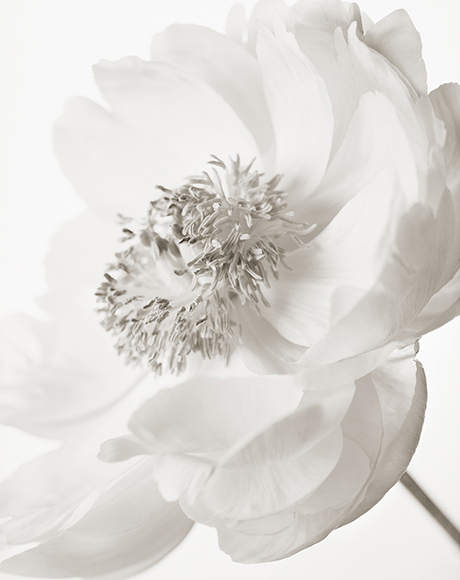 By Rui Kodemari (novelist)
By Rui Kodemari (novelist)
May 21, 2014
It began as an encounter with whiteness.
I first discovered the photography of Yumiko Izu at a gallery on the outskirts of Woodstock, New York. I was immediately struck by her mysterious backdrop of white, which, like a fog, seemed to envelope—or, more precisely, absorb—the flowers at the center of each photo. Flowers, it occurred to me, weren’t the object of Izu’s attention and interest. No, it was whiteness that captivated her.
Several years later, on a visit to Izu’s lakeside studio, I met up with the flowers again. On this occasion, my encounter was one with blackness.
Tranquil blackness. Rich, intense, velvety blackness. A blackness residing at the center of her artistic vision. Recently seduced by Faraway, Yumiko’s photos of animal skulls, I found myself utterly enraptured by her world. In a flash of awakening, I beheld a garden in which white and black—life and death—were laid side-by-side, entwined, allowed to flourish and bloom.
Gazing continuously—standing in the midst of this garden–a strange reversal occurred before my eyes. Once black; now bright, beautiful, articulate—the decaying, rootless flowers emerged from their protective sphere of blackness, coming to life, as if darkness were the motivating principle of their lives and vitality. The beauty of whiteness, by contrast, seemed violent and imbued with terror. A terror infinitely close to death. The stark white of funeral garments. The whiteness of bleach. The return to a blank page. Fastidious, pure, exclusionary white. If black is the seductive color of darkness in the world we inhabit, white is the merciless nullity of the afterlife.
Seeing the reversal of black and white, of life and death, I experienced a realization: The “beauty” encapsulated in Izu’s flowers is both the brief spark of life and inevitable sigh of death. At the same time, her flowers are an embodiment of a soul that none of us has yet witnessed.
From the moment of our birth, we progress, steadily and surely, in the direction of death. Consequently, living can be equated with dying. In Izu’s art, we are able to behold the afterlife—a zone of tranquility, a hiding place for the spirit.
“Keep this to yourself. Preserve this as our secret,” whisper the flowers. In their embrace, we’re unable to escape, unwilling to flee, entranced by the secret pact between life and death. At home, in the Secret Garden.
Essay
Darkness and the Afterlife: Experiencing Yumiko Izu’s Secret Garden
井津由美子の闇と黄泉 「シークレット・ガーデン」に寄せて
小手鞠るい(こでまり・るい)小説家
2014年5月21日
出会いは「白」だった。
ニューヨーク州ウッドストックの町はずれにあるアートギャラリーで、初めて井津由美子の作品を見たとき、私は、花たちの背景を流れる霧のような白に惹かれた。花を包み込む、というよりは、花を吸い込んでいるかのような、幽玄な白。もしかしたら、この写真家が撮ろうとしているのは、花ではなく白なのではないかとさえ思った。
それから長い年月が過ぎて、写真家の暮らす湖畔のスタジオで「シークレット・ガーデン」の花たちに再会する機会に恵まれた私は、そこで初めて「黒」に出会った。
静謐な黒。漆黒のビロードのような黒。井津由美子の真骨頂とも言える闇の色である。 少し前に、動物たちの頭蓋骨を撮ったシリーズ『闇の彼方へ』—Farawayに魅了されていた私はたちまち、この黒の虜になった。白と黒、すなわち、生と死が隣り合わせになって、ときには綯い交ぜになって咲いていてこそ、それこそが井津由美子の創り出す庭だったのだと、目から鱗が落ちるような思いを味わった。
じっと見つめていると—この庭にたたずんでいると—私の目の前で、不思議な反転が起こった。黒に浮かび上がる花たちの、なんと妖艶で可憐で饒舌なこと。黒に優しく守られて、根を持たない花が、朽ちていこうとしている花が、生かされている。黒が花たちの「生」と、その最期の躍動をつかさどっているかのように。対する白の、ある種の恐怖にも似た、残酷なまでの美しさはどうだろう。限りなく「死」に近いこの白。白装束の白。漂白。白紙にもどす。潔癖で、純粋で、排他的な白。黒は、現世の艶めかしい闇の色。白は、死後の容赦ない無の色。
黒と白が逆転し、生と死が入れ替わるのを目の当たりにして、私は悟った。この写真家の写し出す花々の「美」は、つかのまの生の輝きであると同時に、きたるべき死の息吹でもある。あるいは、こうも言えるだろうか。ここで咲いている花たちはどれも、誰もがいまだ目にしたことのない「魂」の化身なのであると。
誰もが、生まれた瞬間から刻一刻、死へと向かってひた進んでゆく。生きている、ということはすなわち、死んでゆくことに、ほかならない。彼女の写真に私は、そんな私たちの行き着く先にある、安息の地であり、魂の隠れ処でもある、黄泉の世界を見る。「だけど、だれにも言わないで。これは、あなたとわたしだけの秘密よ」ささやきかけてくる花たちに囲まれて、ひとたび迷い込んでしまったら、脱け出すことはできないし、抜け出したくなくなる。ここは、生と死が密約を交わした、シークレット・ガーデンなのである。